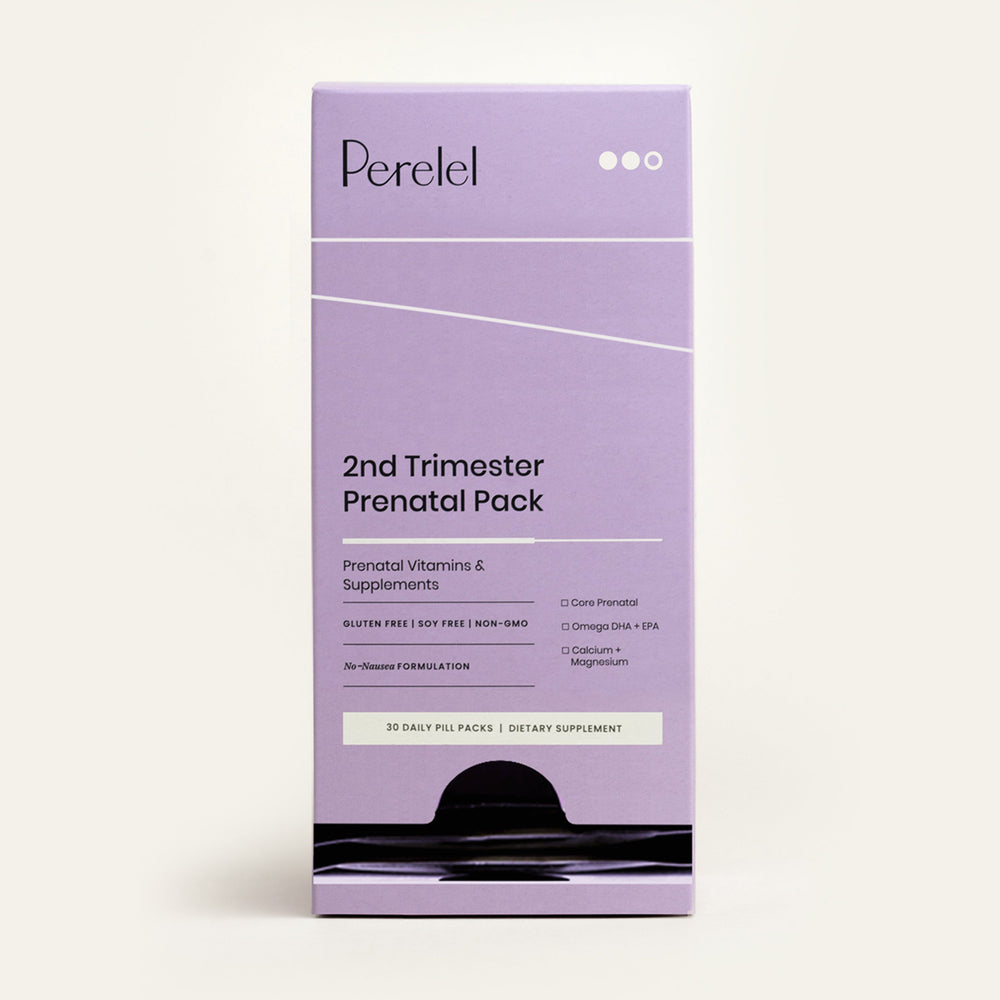Vitamin D is a rather unique nutrient: It’s synthesized from cholesterol in your skin when it’s exposed to sunlight. It has a big job, supporting several different critical processes in the body. And during pregnancy, vitamin D is especially important since it helps protect against a number of adverse health outcomes for both mom and baby.
We checked in with Perelel Medical Co-founder, Dr. Banafsheh Bayati, MD, OB/GYN, FACOG, to find out everything there is to know about the role of vitamin D in pregnancy—from the benefits to evidence-based recommendations on how much to consume, to the best sources.
Keep reading for our comprehensive guide to vitamin D and pregnancy.
How Does Vitamin D Support a Healthy Pregnancy?
Vitamin D plays a big role in helping the body absorb calcium, which is vital for building and maintaining strong bones in pregnant people and their growing babies.
Not only does it help us have healthy bones, but it also helps to regulate the immune system, which becomes weakened during pregnancy, making us prone to infections and other illnesses.
Vitamin D deficiency happens when you don't get enough vitamin D from your diet or sunlight. Vitamin D deficiency during pregnancy can lead to risks and complications for pregnant people and their babies.
How much vitamin D should a pregnant woman take?
Recommended Dietary Allowances (RDAs) for vitamin D have been established by the Food and Nutrition Board of the Institute of Medicine.
Although these guidelines are helpful, according to Dr. Bayati and other experts, recommendations regarding optimal vitamin D intake in pregnant women are quite conservative. Especially since low levels are very common due to a variety of reasons like ethnicity and skin tone, extensive skin covering, liberal use of sunscreen, obesity, low dietary vitamin D intake, smoking, as well as seasonal variations.
“Given the importance of vitamin D on maternal immunity as well as fetal development and pregnancy outcomes, it is wise to have your vitamin D levels tested and optimized prior to pregnancy,” says Dr. Bayati. “It is also important to adequately and yet cautiously supplement during pregnancy.”
$49.95
$49.95
$49.95
Shop the Article:


1st Trimester Prenatal Pack
/ Month
Shop Now


2nd Trimester Prenatal Pack
/ Month
Shop Now


3rd Trimester Prenatal Pack
/ Month
Shop Now
Can you take too much vitamin D when pregnant?
There is little data available on the impact and safety of high doses of vitamin D, especially during pregnancy. But Dr. Bayati says it’s definitely possible to overdo it.
“It's not advised to supplement with more than 4000 IUs per day," says Dr. Bayati. Most prenatal vitamins typically contain 400 IUs of vitamin D per tablet.
Although vitamin D toxicity is very rare, it is possible.1 If you’ve taken too much, you may experience some or all of the following symptoms: Confusion, lack of concentration, drowsiness2, depression, vomiting, abdominal pain, constipation, and high blood pressure.3


What are your
stage-specific needs?
Let us personalize your vitamin routine in 60 seconds.
Can low levels of vitamin D cause pregnancy complications?
It’s estimated that more than 40 percent of American adults have a vitamin D deficiency.4 Existing data suggests that vitamin D deficiency is common in pregnant women and in breastfed infants, despite the widespread use of prenatal vitamins. Deficiency is of particular concern in certain high risk groups like vegetarians, those with little exposure to sunlight and ethnic minorities—especially those with darker skin.
In the general population, low serum vitamin D levels are associated with an increased risk of certain types of cancers, autoimmune disease, neurological disease, insulin resistance and cardiovascular disease.5 In pregnant women, deficiency is linked to a wide variety of adverse health outcomes for both mom and baby.
"Low levels of vitamin D during pregnancy have been associated with maternal periodontal disease during pregnancy as teeth are a source of calcium easily mobilized in women with deficient vitamin D levels,” says Dr. Bayati. “Osteoporosis is an important health issue that can be exacerbated in women with low vitamin D levels—especially those with multiple pregnancies. Adequate vitamin D and calcium in utero and early postnatal life are also key for optimized bone mass for the infant.”
Observational studies suggest lower vitamin D levels may also be associated with higher risks of preeclampsia, gestational diabetes, preterm birth as well as intrauterine growth restriction. Currently, studies are looking at associations with risks of asthma, bone health, allergies and impaired neurodevelopment as well.
“Recommendations for women who are deficient in vitamin D during pregnancy suggest levels below 4000 IU per day and ideally, between 1000 to 2000 IU per day,” Dr. Bayati says.

What are the best ways to get Vitamin D?
Unfortunately, no matter how healthy your diet, chances are good you're not consuming enough vitamin D since very few foods naturally contain this nutrient. And those that do, like salmon, tuna, trout, mackerel, cod liver oil and other fish oils, beef liver, egg yolks, cheese and some mushrooms, don’t provide nearly enough to satisfy the body's requirements. Aside from these foods, there are three primary sources of vitamin D.
-
Fortified Foods
In the 1930s, the United States began fortifying milk with vitamin D in an effort to eliminate rickets, a disease caused by vitamin D deficiency that softens and weakens the bones. Since then, more foods have undergone fortification, including breakfast cereals and some brands of orange juice, yogurt and plant-based milks (soy, almond and oat). Because it is not present naturally in many foods, fortified foods are the primary dietary source of this nutrient for those living in the U.S.6
-
Sun Exposure
One of the most unique attributes of vitamin D is that it is synthesized when ultraviolet (UV) rays from sunlight strike bare skin.7 That's why you'll hear it referred to often as the “sunshine vitamin."
And according to Dr. Bayati, ”Although food may provide small amounts of D3 and D2, exposure to the sun is a main source of vitamin D.”
But relying on the sun as your sole source of vitamin D is problematic—several factors impact the body’s ability to produce and absorb this nutrient, including where you live, the season, your skin pigmentation, age, your weight status, and the health and absorption capacity of your intestines. Clouds, smog, windows, obesity, old age, and having dark-colored skin all decrease the amount of vitamin D your skin produces.5
Not only that, UV radiation from sunshine can cause skin cancer, so although sunscreen can reduce vitamin D production, experts still recommend using sunscreen with a sun protection factor (SPF) of at least 15 SPF if you'll be out in the sun.
-
Dietary Supplements
“Given that dietary vitamin D usually only reaches about 100 to 200 IU per day, most women require supplementation," says Dr. Bayati. But, do so carefully, she cautions. “It is important to carefully supplement as both low and excessive levels of vitamin D during pregnancy can be an issue,” Dr. Bayati cautions.
Vitamin D can be found in standalone supplements as well as alongside other nutrients in a multivitamin. There are two forms available in supplements, vitamin D3 (cholecalciferol), which is produced in the skin of humans and animals, and vitamin D2 (ergocalciferol), which is derived from plants. Both increase vitamin D in your blood, but research suggests that D3 might raise it higher and for a longer duration than D2. (Perelel's prenatal vitamins contain 2000 IUs of vitamin D3.)
Vitamin D is a fat-soluble nutrient, which means it needs fat in order to be absorbed. Thus, taking a vitamin D dietary supplement with a meal or snack that includes some fat7 helps maximize its impact.8
How important is vitamin D once a baby is born?
Since human milk doesn’t typically provide enough vitamin D to meet the needs of your littlest member of the family, and sun exposure isn't recommended for babies, he or she will likely need a vitamin D supplement. (Our Mom Multi Support Pack contains 2000 IU of vitamin D3.)
Interested in adding vitamin D into your daily supplement routine? Perelel makes vitamins for pregnancy formulated by a panel of top OB/GYNs for each unique trimester.

theFolio in Your Inbox
Sign up to receive doctor-backed, stage-specific content in your inbox each week.
References:
1 Risk assessment for vitamin D - PubMed. https://pubmed.ncbi.nlm.nih.gov/17209171/
This article is for informational purposes only. It is not, nor is it intended to be, a substitute for professional medical advice, diagnosis, or treatment and we recommend that you always consult with your healthcare provider. To the extent that this article features the advice of physicians or medical practitioners, the views expressed are the views of the cited expert and do not necessarily represent the views of Perelel.























